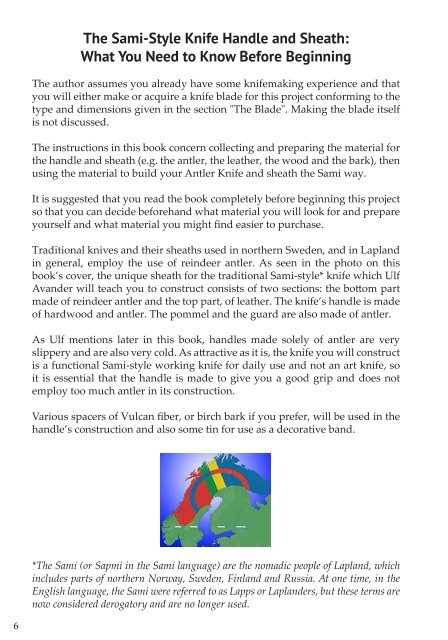Antle Knife: Making a Sami-Style Knife Handle and Sheath
This book’s detailed step-by-step instructions concern 1) selecting and preparing the material for the knife’s handle and sheath (e.g., the antler, the leather, the wood and the bark), then 2) using the material to build a classic and authentic antler knife the Scandinavian way. Most of the comprehensive and valuable instructions in this book, whose author lives in northern Sweden, concern the intricacies of working with antler, a subject in which the author has over 50 years of experience. The instructions will help you to avoid mistakes and to learn important procedures, tricks and tips so you can develop your own style. Although the author uses reindeer antler for this knife, he explains you could also use moose or caribou antler. The author says, “I hope this book will lower the reader’s learning threshold for working with antler, easing the knifemaker into this amazing hobby, and inspire readers to use their imagination and do something new”. Hardcover, 112 pages, 208 color photos and drawings, 10-in. x 7-in x .5-in.
This book’s detailed step-by-step instructions concern 1) selecting and preparing the material for the knife’s handle and sheath (e.g., the antler, the leather, the wood and the bark), then 2) using the material to build a classic and authentic antler knife the Scandinavian way. Most of the comprehensive and valuable instructions in this book, whose author lives in northern Sweden, concern the intricacies of working with antler, a subject in which the author has over 50 years of experience. The instructions will help you to avoid mistakes and to learn important procedures, tricks and tips so you can develop your own style.
Although the author uses reindeer antler for this knife, he explains you could also use moose or caribou antler.
The author says, “I hope this book will lower the reader’s learning threshold for working with antler, easing the knifemaker into this amazing hobby, and inspire readers to use their imagination and do something new”.
Hardcover, 112 pages, 208 color photos and drawings, 10-in. x 7-in x .5-in.
You also want an ePaper? Increase the reach of your titles
YUMPU automatically turns print PDFs into web optimized ePapers that Google loves.
The <strong>Sami</strong>-<strong>Style</strong> <strong>Knife</strong> <strong>H<strong>and</strong>le</strong> <strong>and</strong> <strong>Sheath</strong>:<br />
What You Need to Know Before Beginning<br />
The author assumes you already have some knifemaking experience <strong>and</strong> that<br />
you will either make or acquire a knife blade for this project conforming to the<br />
type <strong>and</strong> dimensions given in the section "The Blade". <strong>Making</strong> the blade itself<br />
is not discussed.<br />
The instructions in this book concern collecting <strong>and</strong> preparing the material for<br />
the h<strong>and</strong>le <strong>and</strong> sheath (e.g. the antler, the leather, the wood <strong>and</strong> the bark), then<br />
using the material to build your <strong>Antle</strong>r <strong>Knife</strong> <strong>and</strong> sheath the <strong>Sami</strong> way.<br />
It is suggested that you read the book completely before beginning this project<br />
so that you can decide beforeh<strong>and</strong> what material you will look for <strong>and</strong> prepare<br />
yourself <strong>and</strong> what material you might find easier to purchase.<br />
Traditional knives <strong>and</strong> their sheaths used in northern Sweden, <strong>and</strong> in Lapl<strong>and</strong><br />
in general, employ the use of reindeer antler. As seen in the photo on this<br />
book’s cover, the unique sheath for the traditional <strong>Sami</strong>-style* knife which Ulf<br />
Av<strong>and</strong>er will teach you to construct consists of two sections: the bottom part<br />
made of reindeer antler <strong>and</strong> the top part, of leather. The knife’s h<strong>and</strong>le is made<br />
of hardwood <strong>and</strong> antler. The pommel <strong>and</strong> the guard are also made of antler.<br />
As Ulf mentions later in this book, h<strong>and</strong>les made solely of antler are very<br />
slippery <strong>and</strong> are also very cold. As attractive as it is, the knife you will construct<br />
is a functional <strong>Sami</strong>-style working knife for daily use <strong>and</strong> not an art knife, so<br />
it is essential that the h<strong>and</strong>le is made to give you a good grip <strong>and</strong> does not<br />
employ too much antler in its construction.<br />
Various spacers of Vulcan fiber, or birch bark if you prefer, will be used in the<br />
h<strong>and</strong>le’s construction <strong>and</strong> also some tin for use as a decorative b<strong>and</strong>.<br />
*The <strong>Sami</strong> (or Sapmi in the <strong>Sami</strong> language) are the nomadic people of Lapl<strong>and</strong>, which<br />
includes parts of northern Norway, Sweden, Finl<strong>and</strong> <strong>and</strong> Russia. At one time, in the<br />
English language, the <strong>Sami</strong> were referred to as Lapps or Lapl<strong>and</strong>ers, but these terms are<br />
now considered derogatory <strong>and</strong> are no longer used.<br />
6










